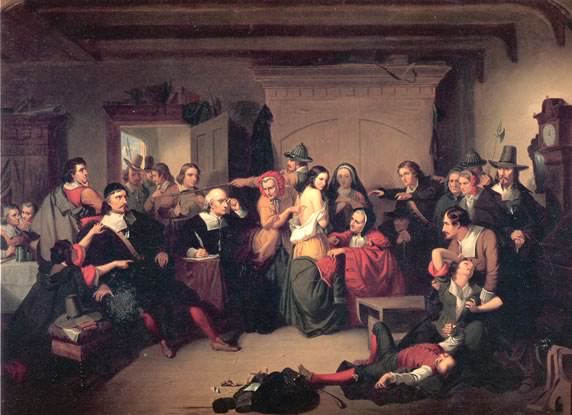
Tomorrow, July 19, 2017 marks the 325th anniversary of the first mass execution of people accused of witchcraft during the infamous Salem Witch Trials. To commemorate the occasion and honor the innocent people killed during the trials, Salem mayor Kimberley Driscoll will dedicate a memorial wall erected on the site of the hangings (see this article from The Smithsonian for more information on the memorial). The mass hysteria, theatrical trials, and execution of innocents make the Salem Witch Trials both a tragic and fascinating piece of pre-American history. If you’d like to learn more about this event or experience it through the eyes of a fictional character, check out the books below available from your library.
A Storm of Witchcraft: The Salem Trials and the American Experience by Emerson W. Baker
Historians have speculated on a web of possible causes for the witchcraft that stated in Salem and spread across the region-religious crisis, ergot poisoning, an encephalitis outbreak, frontier war hysteria–but most agree that there was no single factor. Rather, as Emerson Baker illustrates in this seminal new work, Salem was “a perfect storm”: a unique convergence of conditions and events that produced something extraordinary throughout New England in 1692 and the following years, and which has haunted us ever since.
Baker shows how a range of factors in the Bay colony in the 1690s, including a new charter and government, a lethal frontier war, and religious and political conflicts, set the stage for the dramatic events in Salem. Engaging a range of perspectives, he looks at the key players in the outbreak–the accused witches and the people they allegedly bewitched, as well as the judges and government officials who prosecuted them–and wrestles with questions about why the Salem tragedy unfolded as it did, and why it has become an enduring legacy.
A Fever in Salem: A New Interpretation of the New England Witch Trials by Laurie Winn Carlson
This new interpretation of the New England Witch Trials offers an innovative, well-grounded explanation of witchcraft’s link to organic illness. While most historians have concentrated on the accused, Laurie Winn Carlson focuses on the afflicted. Systematically comparing the symptoms recorded in colonial diaries and court records to those of the encephalitis epidemic in the early twentieth century, she argues convincingly that the victims suffered from the same disease. A unique blend of historical epidemiology and sociology.
 I, Tituba: Black Witch of Salem Village by Maryse Conde
I, Tituba: Black Witch of Salem Village by Maryse Conde
At the age of seven, Tituba watched as her mother was hanged for daring to wound a plantation owner who tried to rape her. She was raised from then on by Mama Yaya, a gifted woman who shared with her the secrets of healing and magic. But it was Tituba’s love of the slave John Indian that led her from safety into slavery, and the bitter, vengeful religion practiced by the good citizens of Salem, Massachusetts. Though protected by the spirits, Tituba could not escape the lies and accusations of that hysterical time.
The Heretic’s Daughter by Kathleen Kent
In 1752 Sarah Carrier Chapman, confined to her home and weak with infirmity, writes a letter to her granddaughter, revealing the secret she has guarded closely for six decades. It is a haunting account of the horrors that enveloped a New England town called Salem, and compelled Sarah, then just a young girl, to make a decision that, would change her life forever.
A little more than a year before the witch trials will begin, Sarah and her family arrive in nearby Andover to face a community gripped by superstition and fear. With the increase in Indian raids and the spread of the plague, the Puritans come to believe that heretics in their midst are responsible for their misfortune. Based on the accusations of a dozen young girls, neighbor is pitted against neighbor, friend against friend, and the hysteria escalates, sweeping more than two hundred men, women, and children into prison on charges of witchcraft – Sarah’s mother, Martha Carrier, among them.
Often at odds with each other, mother and daughter must now stand defiantly together in the face of imprisonment, torture, and even death. Out of love for her children, Martha asks Sarah to commit an act of heresy – a lie that will most surely condemn Martha even as it will save her daughter.
Salem Witch Judge: The Life and Repentance of Samuel Sewall by Eve LaPlante
In 1692 Puritan Samuel Sewall sent twenty people to their deaths on trumped-up witchcraft charges. The nefarious witch trials in Salem, Massachusetts represent a low point of American history, made famous in works by Longfellow, Nathaniel Hawthorne (himself a descendant of one of the judges), and Arthur Miller. The trials might have doomed Sewall to infamy except for a courageous act of contrition now commemorated in a mural that hangs beneath the golden dome of the Massachusetts State House picturing Sewall’s public repentance. He was the only Salem witch judge to make amends.
But, remarkably, the judge’s story didn’t end there. Once he realized his error, Sewall turned his attention to other pressing social issues. Struck by the injustice of the New England slave trade, a commerce in which his own relatives and neighbors were engaged, he authored “The Selling of Joseph,” America’s first antislavery tract. While his peers viewed Native Americans as savages, Sewall advocated for their essential rights and encouraged their education, even paying for several Indian youths to attend Harvard College. Finally, at a time when women were universally considered inferior to men, Sewall published an essay affirming the fundamental equality of the sexes.
In Salem Witch Judge, acclaimed biographer Eve LaPlante, Sewall’s great-great-great-great-great-great-granddaughter, draws on family lore, her ancestor’s personal diaries, and archival documents to open a window onto life in colonial America, painting a portrait of a man traditionally vilified, but who was in fact an innovator and forefather who came to represent the best of the American spirit.
Six Women of Salem: The Untold Story of the Accused and Their Accusers in the Salem Witch Trials by Marilynne K. Roach
Six Women of Salem is the first work to use the lives of a select number of representative women as a microcosm to illuminate the larger crisis of the Salem witch trials. By the end of the trials, beyond the twenty who were executed and the five who perished in prison, 207 individuals had been accused, 74 had been “afflicted,” 32 had officially accused their fellow neighbors, and 255 ordinary people had been inexorably drawn into that ruinous and murderous vortex, and this doesn’t include the religious, judicial, and governmental leaders. All this adds up to what the Rev. Cotton Mather called “a desolation of names.”
The individuals involved are too often reduced to stock characters and stereotypes when accuracy is sacrificed to indignation. And although the flood of names and detail in the history of an extraordinary event like the Salem witch trials can swamp the individual lives involved, individuals still deserve to be remembered and, in remembering specific lives, modern readers can benefit from such historical intimacy. By examining the lives of six specific women, Marilynne Roach shows readers what it was like to be present throughout this horrific time and how it was impossible to live through it unchanged.
The Witches: Salem, 1692 by Stacy Schiff
It began in 1692, over an exceptionally raw Massachusetts winter, when a minister’s daughter began to scream and convulse. It ended less than a year later, but not before 19 men and women had been hanged and an elderly man crushed to death.
The panic spread quickly, involving the most educated men and prominent politicians in the colony. Neighbors accused neighbors, parents and children each other. Aside from suffrage, the Salem Witch Trials represent the only moment when women played the central role in American history. In curious ways, the trials would shape the future republic.
The Witch of Blackbird Pond by Elizabeth George Speare
Sixteen-year-old Kit Tyler is marked by suspicion and disapproval from the moment she arrives on the unfamiliar shores of colonial Connecticut in 1687. Alone and desperate, she has been forced to leave her beloved home on the island of Barbados and join a family she has never met. Torn between her quest for belonging and her desire to be true to herself, Kit struggles to survive in a hostile place. Just when it seems she must give up, she finds a kindred spirit. But Kit’s friendship with Hannah Tupper, believed by the colonists to be a witch, proves more taboo than she could have imagined and ultimately forces Kit to choose between her heart and her duty.
